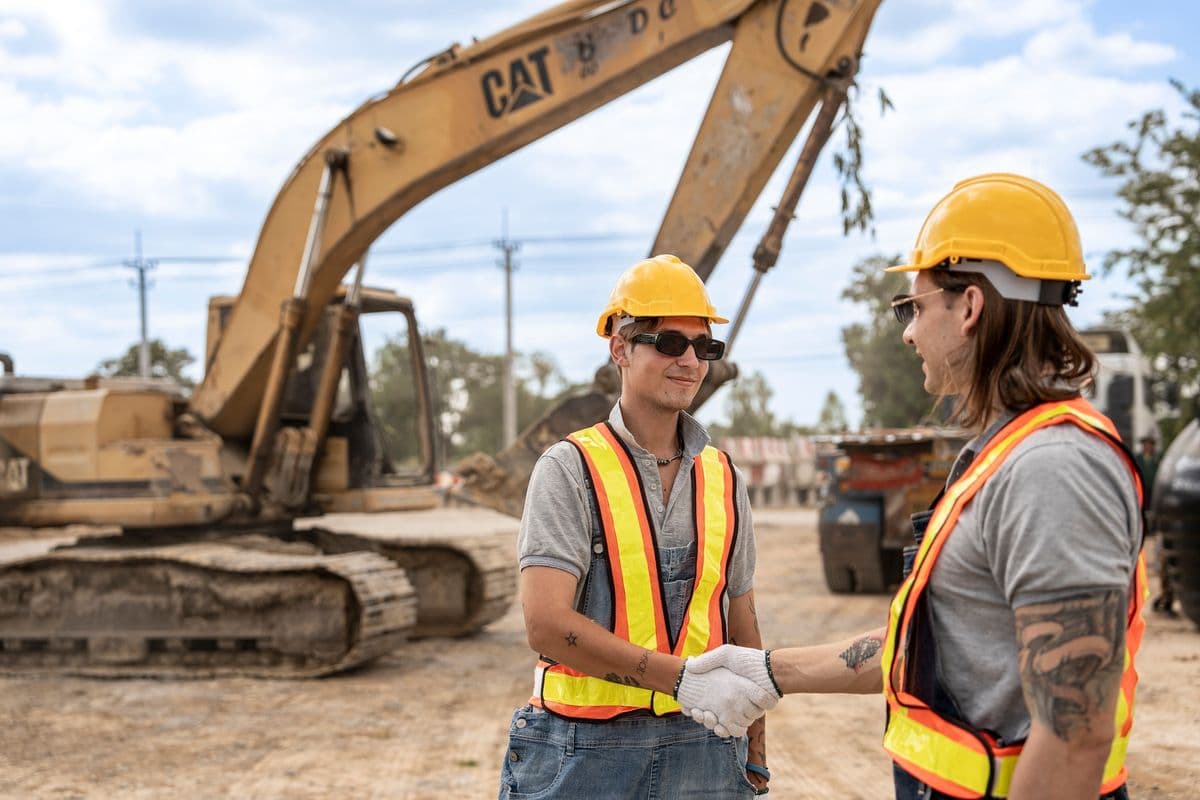Key Insights for a Smarter Build
- Data is the foundation: Just like concrete is the bedrock of physical structures, clean, structured data is the essential material for effective AI in construction. Without it, even the smartest algorithms can't deliver real value.
- AI learns from data: AI isn't magic; it learns from patterns in your project timelines, financial records, safety reports, and even weather. This means that if your data is messy or fragmented, the insights you get back will be, well, messy too.
- Integrated platforms are crucial: To truly leverage data and AI, you need a central system that brings everything together—from estimating to procurement to site management. This creates a single source of truth, enabling informed decisions and unlocking AI's full potential.
You know what’s funny? We pour millions of tons of concrete every year to build our world. It’s absolutely foundational. But when we talk about AI in construction, a lot of folks get excited about the robots and the fancy software, and they often forget the real unsung hero: data. Honestly, without good data, your AI project is like trying to build a skyscraper on quicksand. It just won’t work.
Data is quietly becoming the new concrete. It’s the fundamental, load-bearing material for any intelligent construction. You just can’t have a strong, resilient structure without a solid base, can you?
The Bedrock of Modern Construction
Why your project's future depends on more than just physical materials.
Think about AI for a second. It doesn't "think" in the human sense; it learns. And what does it learn from? Data. Mountains of it. Your project timelines, every single supplier invoice, safety reports, equipment logs, even the weather patterns on site—all of that is pure gold. This information, when it's clean and connected, lets AI spot patterns and trends that we humans might never even notice. It’s like having X-ray vision for your project.
It can predict a potential delay weeks before it happens, just by analyzing historical schedules and current progress. Or it might flag a cost overrun by comparing your actual spending against the budget in real time. But here’s the catch, and it’s a big one: if you feed it messy, scattered, or inaccurate data, you’ll get nonsense back. It’s that simple. We call it "garbage in, garbage out" in the tech world, and it applies perfectly here.

Analyzing industrial production data is critical for informed decision-making.
AI Transformation? It's a Data Project, really.
A lot of people get really excited about the AI part and then completely forget about all the hard work that has to come first. Implementing AI isn’t just about buying a software license and flipping a switch. Oh no. It’s about getting your data house in order. You need to connect your sites, your main office, and all your teams onto a single, unified platform where information flows freely, like a well-designed plumbing system.
This is precisely where a system like Archdesk truly shines. It’s built to be that central source of truth, pulling together everything from procurement and job costing to document management and live site data. It takes the chaos and gives it structure. Without this kind of foundational approach, even the most powerful AI tools from big names like Procore or Autodesk Construction Cloud will struggle to deliver any real, tangible value. They need that clean, structured concrete to build upon, you know?
The Cost of Shaky Foundations
Understanding the real risks of poor data.
What’s the actual cost of bad data? It’s far more than just a faulty report that no one reads. It’s misplaced orders that delay the entire job, throwing schedules into disarray. It’s invoices that don’t quite match the work that was actually done, leading to frustrating payment disputes and strained relationships. And even worse, it’s safety hazards that go unnoticed because the incident reports are buried deep in someone’s overflowing email inbox.
When your data is fragmented, your entire company becomes fragmented. Decisions start getting made in the dark, based on guesswork instead of solid evidence. AI promises to bring light into those dark corners, but only if you give it the right fuel. It’s like trying to run a high-performance engine on cheap, dirty fuel—it just won’t perform.
Advanced construction technology integrates seamlessly with robust data systems.
Pouring Your Data Foundation
Where to begin with building your data strategy.
So, where do you even start with all of this? You don’t need to try and boil the ocean all at once. Begin with one clear pain point. Is it cost control that keeps you up at night? Then start by tracking your budgets and expenses in a unified system. Is scheduling always a headache? Get your timelines and resource allocations into a digital, organized format.
The main goal here is to break down those old, stubborn data silos. When your project managers, your accountants, and your site supervisors are all working from the exact same numbers, everything changes. You start to create a culture where decisions are based on solid evidence, not just gut feelings or "how we’ve always done it." And suddenly, AI isn’t some scary, futuristic concept. It’s the natural next step—a powerful tool that helps you make sense of all the data you’re already collecting.
The radar chart above illustrates a comparative analysis of Archdesk's data capabilities against typical fragmented systems in construction. Archdesk consistently scores higher across key metrics such as Data Quality, Integration Capability, Real-time Insights, Predictive Accuracy, and Safety Enhancement, demonstrating the robust foundation it provides for AI-driven transformation compared to the challenges posed by disparate data sources.
Archdesk: Your Central Hub for Intelligence
Bringing everything together, just like it should be.
You can try to stack up a bunch of individual, disconnected tools, or you can choose one comprehensive system that actually mirrors how your company already works. Archdesk brings bids, budgets, procurement, scheduling, document control, RFIs, change management, subcontractor pay applications, and comprehensive dashboards all into one single place. What does that mean for you?
- One job number: Across estimating, purchasing, and invoicing, everything ties back to one consistent job number. No more confusion.
- Live cost tracking: You get real-time cost-to-complete and margin-by-activity, helping you avoid those nasty end-of-month surprises.
- Integrated schedules: Schedules are directly tied to procurement and labor, so potential slips show up long before they snowball into major problems.
- Mobile field logs: Your field teams can enter data easily on mobile devices, feeding the same reliable database your finance team trusts.
Sure, competitors like Procore are strong on collaboration, and Autodesk Construction Cloud is great for design-to-field workflows. Viewpoint offers deep accounting functionalities. But Archdesk? It stitches the whole thread together, end to end. And that’s exactly what modern AI models desperately need to truly learn and provide valuable insights.

This mindmap illustrates the interconnectedness of data and AI in construction. It highlights how various data types serve as the "new concrete" for AI, addressing the challenges of fragmented information by advocating for integrated platforms like Archdesk, ultimately leading to significant operational benefits.
Quick Wins with Archdesk
See the difference in just a few projects.
When you start using Archdesk, you can see real, tangible benefits fairly quickly:

This isn't about flashy, abstract AI. It’s about practical improvements that hit your bottom line and make your teams happier and safer. You know, a happy team is a productive team.
The Human Element: Field Reality and Culture
Making data collection painless for your team.
Honestly, people hate double entry. So, don’t ask them to do it! Set up short, simple forms on mobile devices. A two-minute daily log, a photo with a quick tag, maybe even a voice note if that’s easier. Your foremen will use it if it actually saves them a phone call or a headache. You know what? A little bit of "bribery" helps too: show your crews how their simple entries directly remove rework or speed up approvals. That kind of proof really builds good habits.
Building a culture around data means showing everyone the value it brings to their daily work. It’s not just more admin; it’s about making their jobs easier and more efficient. When they see that, they’re in.
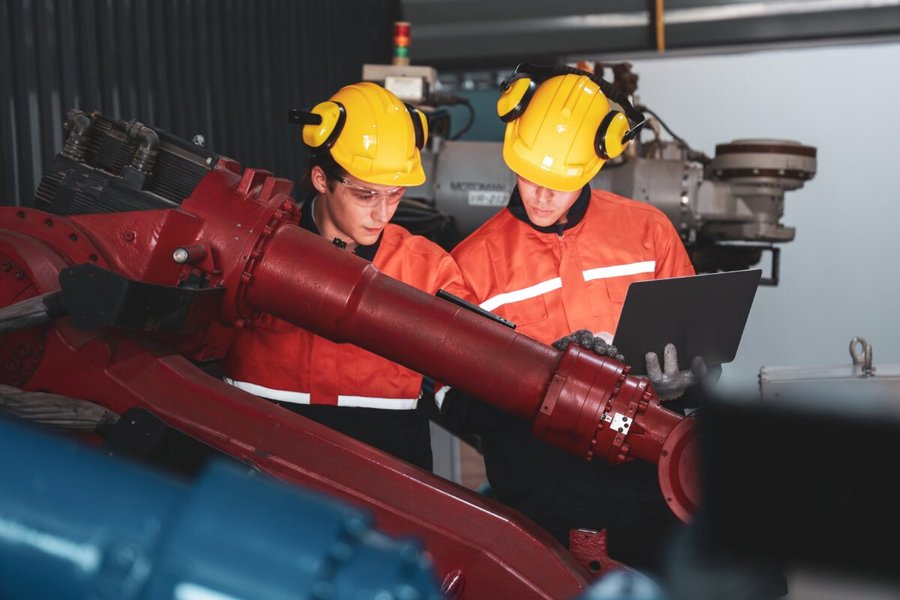
Engineers leveraging data analysis on robotic machinery to optimize construction processes.
Security and Ownership: Your Data, Your Control
Keeping your valuable information safe and accessible.
Owners always ask who holds the data. And you absolutely should ask that. When you centralize your operations on Archdesk, you get clear permissions, detailed audit trails, and seamless integrations with your existing finance stack. This means your data is secure, and you always maintain ownership and control. Keep exports routine, too. If you ever need to model something outside the platform, your data is already perfectly structured and ready to go.
What Good Looks Like in 90 Days
A realistic timeline for embracing data-driven construction.
Here’s a rough idea of how quickly you can start seeing results:
- Weeks 1-2: Pick two live projects. Standardize your job codes, cost codes, and document naming conventions. It’s time to banish those rogue spreadsheets once and for all.
- Weeks 3-4: Turn on daily logs, RFIs, and purchase orders within Archdesk. Integrate it smoothly with your accounting system.
- Weeks 5-8: Start monitoring key dashboards: earned value, committed versus budget, RFI cycle time, and delivery reliability. Focus on a small list that provides a high signal.
- Weeks 9-12: Use Archdesk’s reporting features to fine-tune your estimates with actual productivity and waste factors. Roll those lessons over to your next bid, making it even stronger.
Oh, and a little seasonal thought: if you’re in North America heading into winter, weather swings will definitely impact your schedule and heat costs. Start capturing weather tags on tasks now. Your data model will thank you by spring, trust me. For our friends in the GCC, you already know heat windows dictate labor output; logging start times and breaks helps protect workers and your program. And in Europe, with energy prices still a bit wobbly, tracking temporary power usage can really keep those preliminary costs honest.
A Quick Look at the Landscape
Comparing solutions without making a big fuss.
Let's be honest, there are some great tools out there. Procore is excellent for collaboration and its partner apps are solid, though you might still be piecing together finance and estimating functions. Autodesk Construction Cloud excels with design and issue tracking, but cost control can sometimes feel disconnected from your main ERP. And systems like Viewpoint offer deep accounting, but sometimes field adoption can lag a bit.
Archdesk, though? It really balances field operations, cost control, and scheduling in one smooth, integrated flow. That’s why your data stays consistent enough for AI to truly learn and provide meaningful insights. It’s not about being the best at one tiny thing; it’s about making everything work together beautifully.
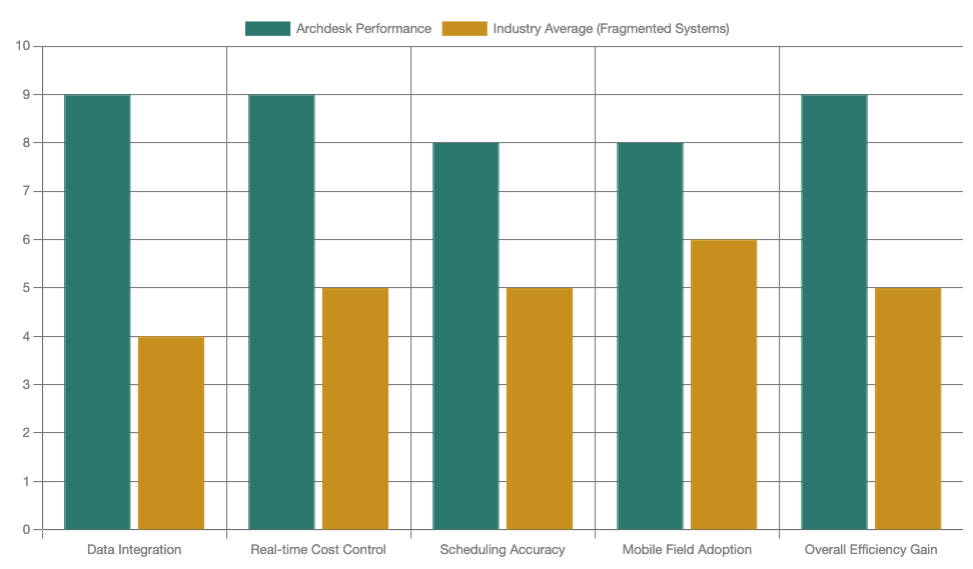
The bar chart above provides a comparative overview of Archdesk’s performance against the industry average for fragmented systems across key operational metrics. Archdesk demonstrates significantly higher scores in Data Integration, Real-time Cost Control, Scheduling Accuracy, Mobile Field Adoption, and Overall Efficiency Gain, underscoring its superior capability in consolidating and leveraging data for enhanced project management.
The Quiet Payoff
Less drama, more predictability.
Once your data flows freely and consistently, even simple models can do so much. They can forecast delays based on RFI density, flag potential overruns on crews by mid-month, or suggest optimal reorder points from delivery variances. It’s not about being flashy. It’s simply about fewer surprises and steadier, more predictable margins. And honestly, isn’t that what every construction CEO dreams of?
A Final Thought for CEOs and Owners
Your move, your future.
If you're a CEO or owner, here’s one policy to consider: no job starts without a job number and proper codes from day one. Then, back your teams with a platform, like Archdesk, that keeps the admin light, the data tight, and the overall picture crystal clear. It’s concrete work, sure. But that’s precisely the point, isn't it?
Frequently Asked Questions
What does "data is the new concrete" mean for construction?
It means that just like concrete forms the physical foundation of buildings, clean and structured data is now the essential foundation for any successful AI implementation in construction. Without robust data, AI tools cannot provide reliable insights or predictions.
Why is data quality so important for AI in construction?
AI learns from the data it's fed. If the data is messy, inaccurate, or incomplete ("garbage in"), the insights and predictions generated by the AI will also be flawed ("garbage out"). High-quality data ensures accurate learning and valuable outputs from AI systems.
How can Archdesk help manage construction data effectively?
Archdesk acts as a central source of truth, integrating various aspects of construction projects like estimating, procurement, scheduling, document management, and cost control into one platform. This unified approach breaks down data silos, ensures consistency, and provides the structured data needed for effective AI integration.
What are some immediate benefits of adopting a data-driven approach in construction?
Immediate benefits include more accurate cost estimates, better change control management, improved delivery logistics, and enhanced safety trend identification. These lead to fewer project surprises, reduced delays, and ultimately, better financial margins.
Is implementing a data-driven system a complex process?
While it requires effort, it doesn't have to be overwhelming. You can start by addressing one key pain point, like cost control or scheduling, and gradually integrate more data streams. The key is to standardize data collection and ensure all teams are using a unified system.


